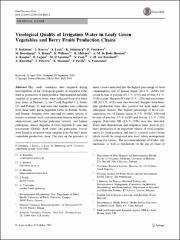| dc.description.abstract | This study condenses data acquired during
investigations of the virological quality of irrigation water
used in production of fresh produce. One hundred and eight
samples of irrigation water were collected from five berry
fruit farms in Finland (1), the Czech Republic (1), Serbia
(2), and Poland (1), and sixty-one samples were collected
from three leafy green vegetable farms in Poland, Serbia,
and Greece. Samples were analyzed for index viruses of
human or animal fecal contamination (human and porcine
adenoviruses, and bovine polyoma viruses), and human
pathogenic viruses (hepatitis A virus, hepatitis E virus, and
noroviruses GI/GII). Both index and pathogenic viruses
were found in irrigation water samples from the leafy green
vegetables production chain. The data on the presence of index viruses indicated that the highest percentage of fecal
contamination was of human origin (28.1 %, 18/64), followed
by that of porcine (15.4 %, 6/39) and bovine (5.1 %,
2/39) origins. Hepatitis E virus (5 %, 1/20) and noroviruses
GII (14.3 %, 4/28) were also detected. Samples from berry
fruit production were also positive for both index and
pathogenic viruses. The highest percentage of fecal contamination
was of human origin (8.3 %, 9/108), followed
by that of porcine, 4.5 % (4/89) and bovine, 1.1 % (1/89)
origins. Norovirus GII (3.6 %, 2/56) was also detected.
These data demonstrate that irrigation water used in primary
production is an important vehicle of viral contamination
for fresh produce, and thus is a critical control point
which should be integrated into food safety management
systems for viruses. The recommendations of Codex Alimentarius,
as well as regulations on the use of water of appropriate quality for irrigation purposes, should be
followed. | en_US |
| dc.description.sponsorship | This work was supported by a European Community’s
Seventh Framework Programme (FP7/2007–2013) under
Grant Agreement No. KBBE-213178 (Integrated monitoring and
control of foodborne viruses in European food supply chains, VITAL)
led by the coordination team of Nigel Cook (FERA, UK), Martin
D’Agostino (FERA, UK), and Franco M Ruggeri (ISS, Italy). The
authors are grateful to the owners of the companies who took part in
this study for their kind and skillful collaboration and assistance, and
to all VITAL members. As it concerns VRI, the results of the project
LO1218 were obtained with financial support from the MEYS of the
CR under the NPU I program. | en_US |

